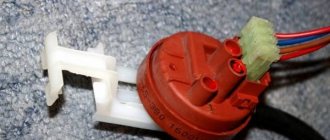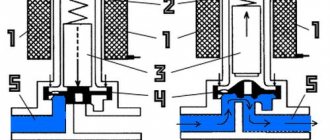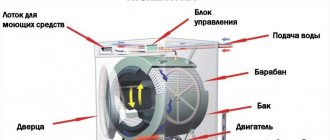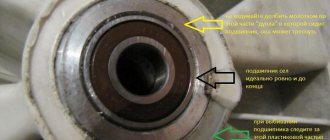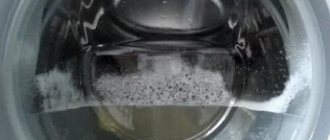We all know that for high-quality washing, not only chemistry and mechanical action are important, but also temperature. It is almost impossible to remove serious stains in cold water. Therefore, if the washing machine stops heating the water, you can forget about effective washing.
Unfortunately, situations where the washing machine does not heat occur all the time. More than half of the requests for washing machines to the RemBytTech workshop begin with the words that the machine generated a heating error immediately after turning on the program or 10–15 minutes after start. Or the SMA endlessly washes, but does not heat the water (this behavior is typical of old washing machines).
If the washing machine fills and drains water
If the washing machine constantly fills and drains water, the machine naturally does not have time to heat it. As a result, modern washing machines stop with an error in the pressure switch, dialing or heating water, and older models work endlessly until the user interrupts the program.
The reasons for the constant supply and drainage of water may be due to incorrect installation of the washing machine or a breakdown. We talked about this in detail in the article “What to do if the washing machine constantly fills and drains water.”
Call the master
If you can’t handle the repair of your washing machine on your own, you can call a technician from a household appliance repair company.
It’s easy to find such an organization on the Internet by searching for the name of your city and “LG washing machine repair.”
When choosing a company, it is better to give preference to companies that have been operating in the market for a long time, value a good reputation and have positive reviews on social networks and on thematic websites. This will prevent you from falling for scammers.
When calling a technician, you should describe the malfunction of your washing equipment and indicate the model. If there is already a heating element available for replacement, the dispatcher should also be told about this.
The average cost of work depends on the complexity of the breakdown. According to MSC, the average prices are as follows:
- repair of the control module board – from RUB 1,500;
- replacement of a temperature sensor – from RUB 1,300;
- replacement of heating elements - from 1,000 rubles. etc.
Washing machine heating errors by brand
Depending on the brand of washing machine, error codes may be as follows:
- Bosch – F19, F22
- Indesit – F03, F08
- Haier - error 4
- LG -
- Siemens – F06, F07, F19, F22
- Samsung – H1, H2, HE, HE1, HE2, E5, E6, NS, NS1, NS2, tE / Ec / tC
- Ariston and Hotpoint-Ariston – F03, F08
- Candy – E05, E14, E16
- Atlant –
- Electrolux – E03, E61, E62, E66, E68, E69, E3A, E71
- Whirlpool – F08
Why did the machine stop heating water and what should I do? Let's look further.
Causes
There are various circumstances that lead to problems with the washing machine. We'll have to figure out what exactly we're dealing with. You need to consider each reason and try to determine which element failed.
Main types of breakdowns:
- The heating element does not heat the water to the required temperature. This device works on the same principle as a boiler. On average, it lasts from 5 to 10 years. The duration depends on how often the washing machine is used. This part cannot be repaired; it must be replaced.
- The temperature sensor is not working. It is he who activates and deactivates the heating element. If the element does not function properly, then heating will not occur.
- The pressure sensor in the tank area is faulty. If it does not send a signal to the ECU that the tank is filled with water, then the heating will not turn on.
- No voltage is supplied to the heating element. This most often happens if the cable chain breaks.
- Failure in the control module assembly.
What to check first
The lack of water heating does not always indicate a breakdown of the heating system in the washing machine. First, check these points.
- Are the mode and temperature selected correctly ? Many modes, such as washing delicate fabrics or woolen items, are carried out without heating in cold water. Perhaps this is the mode you chose. In addition, many older machines allow you to separately adjust the program temperature. Perhaps the regulator is on o. In this case, simply select the desired mode and temperature.
- Is the control board frozen ? Disconnect the SMA from the power supply for 10-15 minutes by unplugging the plug from the outlet. Then turn it on. If the machine started working normally, it was a one-time failure of the control board, and you successfully dealt with it.
Possible problems
In the process of independently repairing an LG washing machine, you can encounter some difficulties and difficult situations:
| Problem | Solution |
| The heating element cannot be removed from the washing machine | You should check whether the screw that holds the part in place is unscrewed. There is no need to panic - the part comes out quite tightly, and this is normal |
| There are doubts about the performance of the heating element | You can check the functionality of the unit using a multimeter |
| The new heating element does not fit | Perhaps the part does not match the washing machine model, this point should be checked |
| You should check whether debris from the tank is interfering with the installation. | |
| After replacing the heating element, the machine began to leak | The new part may not have been installed correctly. |
| The heating element is not suitable for a specific SMA model | |
| After replacing the heating element, water heating was not restored | A worn heating element may not be the only problem. It may be worth turning to professionals for help in diagnosing the condition of the machine. |
| You should check that all contacts are connected correctly |
Possible faults requiring repair
If you selected the heat wash cycle and resetting the electronics did not help, then most likely your washing machine is faulty. According to the experience of RemBytTech specialists, most often the machines do not heat the water due to the breakdown of the following components.
Burnt out heating element - from 1400 rubles.
A heating element is a heating element, which is a housing with a heating coil inside. Typically, heating elements fail due to scale, which forms on their body from impurities of tap water, litter, dust, lint from clothes, as well as undissolved particles of detergents. When scale builds up on the heater, its performance decreases, and the machine tries to compensate for the lack of heat with more intensive operation of the heating element. As a result, either the spiral or the heater body itself burns out.
Failure of the heating element is the most common reason why a washing machine does not heat water.
SIGNS
The washing machine does not heat the water. Modern machines can interrupt the program immediately when turned on, displaying a heating error on the display. In less technologically advanced models, the error occurs after 10-15 minutes, when heating should begin. Old SMAs can wash endlessly: the drum rotates, but since there is no heating, the machine does not go to the rinsing stage, waiting for the water to heat up. Sometimes when the heating element breaks down, the washing machines “knock out the plugs.”
HOW TO FIX
A faulty heating element cannot be repaired; it must be replaced with a new one.
The control module is faulty - from 2000 rubles.
The control module is an electronic component of the washing machine that “manages” its operation. In fact, it is a microcircuit that is very sensitive to power surges and moisture ingress. Because of this, individual radio elements in the control module fail, and the tracks and contacts of microcircuit elements in the heating element circuit burn out or rust. In particular, the heater relay often burns out, but other elements in the heating element circuit on the microcircuit may also fail.
SIGNS
The washing machine does not heat the water. A heating error may appear on the display.
HOW TO FIX
The wizard calls the module elements responsible for heating control. Based on the test results, faulty radio elements, their contacts and tracks are identified. If the microcircuit processor is intact, then the burnt elements are replaced with new ones, the contacts and tracks are soldered. If the processor is faulty or the control unit is damaged in a large area, it is completely replaced.
Faulty temperature sensor - from 1300 rubles.
The sensor measures the temperature of the water in the tank. Based on the data received from it, the SMA turns the heating element on or off. If the sensor is faulty, the machine does not understand what the temperature of the water is in the tank and does not heat the water.
SIGNS
The heating in the washing machine does not work. The display flashes a heating or temperature sensor error code.
HOW TO FIX
The faulty sensor is replaced with a new one.
Damaged wiring or contacts in the heating circuit - from 1,500 rubles.
Often, due to vibrations when working in washing machines, wires fray, and contacts weaken and burn out or oxidize. Wiring can also be damaged by mice and rats (the problem is more common in the private sector).
SIGNS
The machine does not heat the water. The display shows a heating error.
Self-diagnosis and troubleshooting
Initial diagnostics can be carried out without calling a specialist - to determine what the reason is, check the details that we described above. Both visual and technical inspection are required.
Step-by-step instruction:
- Inspect the sensor that monitors the water level in the tank. The pressure switch, or rather its tube, fills with hair and small debris. You can determine the blockage visually by simply looking inside the tube. To get to the hose, you will need to remove the top or side panel of the machine.
- Checking the wires of parts. Most often, the wiring coming from the heating element breaks, but to be sure, inspect all the wires inside the washing machine. Perhaps some of them are frayed, they need to be soldered and insulated with electrical tape.
- Checking and inspection of the heating element. The heating element is checked with a special device - a multimeter. First, they measure its initial resistance without connecting it to the network, then heat it up, measure and compare the resulting numbers. If the indicators are practically the same, the part is faulty. It also happens that an intact and undamaged heating element is preserved under a layer of scale. Read more in our article:
Instructions for checking and replacing the heating element - water heater of washing machines
- Thermostat diagnostics. If the heating element, pressure switch and wiring are normal, but the water is still heating up, check the temperature sensor with a multimeter (in modern machines, a thermistor). Typically, the sensor looks like a small metal cylinder with wires connected to it.
Reasons why the water does not heat up when washing
A number of reasons can lead to a malfunction of the LG washing machine, in which the water does not heat up
- wear and tear of equipment during long-term operation;
- poor quality water;
- unsuitable detergent;
- power surges;
- water getting inside the washing machine body, including the control unit.
To extend the life of your washing machine and avoid breakdowns, you must operate the device responsibly and follow the manufacturer’s recommendations.
How to find the heating element and temperature sensor
To find these two most important elements of a Samsung washing machine, you will have to disassemble its body a little, or rather, disconnect the front wall of the unit. To do this, you should perform the following algorithm of actions:
- provide free access to equipment from all sides;
- disconnect the garbage filter, this will allow you to drain the remaining water in the tank, at the same time, remove the detergent tray;
- go around the back of the washer and start unscrewing the bolts holding the top housing cover;
- unscrew the two fastening screws located under the SMA cuvette and one located on the side, on the right side of the control panel;
- carefully move the control panel, do not remove it yet;
- using a flat-head screwdriver, hook the plastic clamp, which is located around the entire circumference of the hatch, and slowly remove it;
- tuck the hatch cuff deeper into the drum;
- using a flat-head screwdriver, carefully pick up and remove the decorative front panel from the body, so you expose the steel frame of the unit;
- unscrew the 4 bolts located at the bottom of the front wall, before this they were not visible, but after removing the decorative panel they can be easily unscrewed;
- return to the control panel that was moved away earlier, lift it and place it on the top cover of the washing machine. There were 3 more screws hiding under the panel holding the front part of the case, unscrew them.
Important! When lifting the control panel up, watch the electrical wires connecting it to the body. Do not damage them under any circumstances!
The main part of the work is completed, now the front wall is attached to the body with just a couple of hooks. Take it by the lower right and left corners, lift it up slightly and carefully remove it. You should not pull the part towards yourself too much, because it will certainly pull the wiring responsible for blocking the hatch door.
It is better to carefully lower the main panel, which is responsible for controlling the washing machine, down in order to prevent it from accidentally falling during repair work to replace components. Having completed this sequence of actions, you can begin diagnosing the heating element and temperature sensor. After all, now they are literally before your eyes!
Diagnostics of heating element
Failure of the heating element is the most common reason that the water in the washing machine does not heat up. Under normal conditions, the heating element is designed for a long period of operation, 5 - five or more years. However, hard water, low-quality detergents or failure to comply with the operating conditions of the washing unit lead to the formation of scale on the heating element. As a result of this, the heat transfer process is disrupted, the heating element overheats and burns out.
Electric heating elements are used in many household appliances: kettles, pressure cookers, boilers, etc. They can be dry or wet type. Dry heating elements do not come into direct contact with water or other liquid. Washing units from most manufacturers use wet heating elements. Korean washing machines Samsung and LG, Italian Ariston or German Bosch are all equipped with similar heating elements. They may vary in appearance and power.
Household washing units use heating elements with a power of 1.5 to 2.5 kW. The power is usually indicated on the device case, or in the accompanying technical documentation. In order to make sure that the heating element is working, you need a multimeter (tester). To ensure an accurate check, it is better to calculate the resistance for a specific element using the formula:
R=U²/P where:
R – resistance in Ohm;
U – network voltage in V;
P – heating element power W.
For example, let's take a heating element with a power of 2000W (or 2 kW).
R= 220²/2000= 24.2 Ohm
The calculated resistance for a 2 kW heating element was 24.2 Ohms.
To check you need:
- disconnect the wires from the heating element connectors;
- switch the multimeter to resistance measurement mode with a measurement range of no more than 1000 Ohms;
- Touch the probes of the multimeter to the outer terminals (contacts) of the heating element.
If the heating element is working properly, the device readings should be close to the calculated value. “Zero” indicates a short circuit inside the heating element and it needs to be replaced. If the device readings show “one” or the “infinity” symbol, the heating element has a break, and it also requires replacement.
To check the breakdown on the body, the tester switch is set to the “buzzer” mode and one of the probes of the device is connected to one of the contacts of the tank, the other to the body of the heating element. If there is no breakdown in the housing, the multimeter's buzzer will not sound. Otherwise, if the device beeps or displays numbers, then there is a breakdown in the housing, and the heating element requires replacement.
Replacing the heating element
What to do when you finally get to the heating element? You need to check the element using a multimeter. The first probe of the device is carefully installed on one contact of the heater, the second is attached to the second contact. Afterwards, you need to monitor the meter readings displayed on the screen. When the resistance value is within 25-30 Ohms, it means that the heater is working and is functioning normally; if the multimeter display shows the number 0 or 1, therefore, the heating element is not working.
Having purchased a new similar heater, it is necessary to replace the part. To do this you will need a socket wrench. Take the tool and unscrew the nut located between the two contacts of the heating element. This will remove the main fastener that holds the heater in place. But in addition to the nut, the device also has a spacer, so the action plan will be as follows:
- remove the nut;
- grab the contacts of the heater with your hands and carefully swing it in different directions;
- using a small hammer, lightly tap the stud with which the nut was screwed, the stud should fall slightly into the body;
- pry up the heating element using a flat screwdriver, so you can slightly move the heater from its place;
- hold the contacts and pull the element out.
Important! You must pull out the heater by the contacts with extreme caution, and the point is not that it is a pity to damage the non-working part, but that if they accidentally break off, getting the non-working part out of the housing will be quite problematic.
Having pulled out a burnt heating element from the washing machine, you will probably see that the part is covered with a layer of plaque and scale, and you may notice the presence of black spots on it. Take your new heater and test it using a multimeter. After making sure that the element is working properly, you can begin installation. To do this, you need to lubricate the rubber element of the heating element with a drop of machine oil and place the part in the tank. Then the temperature sensor is installed in place, all wiring is connected to the contacts, the SMA is assembled in the reverse order and tested for functionality.
Interesting:
- Rating of Samsung washing machines
- Reviews of Samsung washing machines
- Review of a Samsung washing machine with an additional door
- Review of Samsung washing machines with inverter motor
- Washing synthetics in a washing machine
- Samsung washing machines
Reader comments
- Share your opinion - leave a comment
Damage to the water heating sensor
A device such as a water heating sensor is needed to turn the heating element on and off in a timely manner. If it breaks down, the washing machine stops heating the water.
.
The temperature sensor is tested as follows:
- The sensor is pulled out of the washer and its electrical resistance (R) is measured with an electrical measuring device.
- The element is dipped into heated water, after which its resistance is measured again.
- If the resistance of the sensor in warm water and in cold water is significantly different, then everything is in order with the device. If there is no noticeable difference, you will have to purchase and replace the device.
Identifying the faulty element
If periodic self-draining of warm or hot water occurs (can be monitored by heating the drain hose), it is necessary to eliminate the siphon effect and correctly connect the washing unit to the drain system. The problem is successfully solved by installing a check valve in the system.
If the washing machine does not heat the water at all, you should remove the back or side covers and check the connection of the heating element terminals (TENA) with the current-carrying wires.
When washing, especially in spin modes, all elements of the washing unit are subject to vibration loads, which can lead to separation of the elements. By reconnecting the disconnected wire, you can eliminate the problem.
Washing units from Samsung, LG, Ariston, Candy, Bosch and other well-known brands have a similar structure and connection of heating elements. As a rule, a tubular heating element is used, which converts electrical energy into thermal energy by creating electrical resistance.
Cost of work
LG washing machine does not heat water, what to do
? Should I try to find the cause myself or contact service? If you have a multimeter, then first check the heating element. If it burns out, then buy exactly the same one and replace it yourself. If you call a specialist from the service center, the price of replacing the heater will cost approximately 3,500 rubles. (the price includes a new heating element and the work of a master). But, if the heater is working properly and the water is cold, then it would be optimal to use the help of a technician from the service department. In most cases, repairs will cost 1-2 thousand rubles for the service plus the cost of a new part.
Thus, when the LG washing machine does not heat the water
, don't panic too much. Electronic boards in such machines rarely fail. Most often, the repair will be simple and inexpensive.
Source
